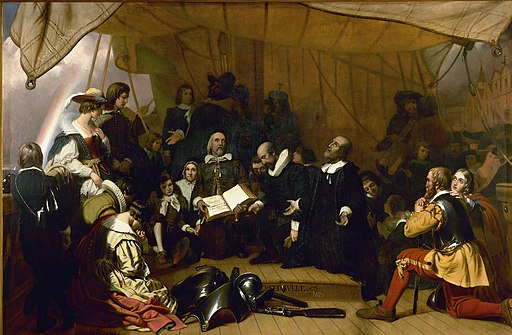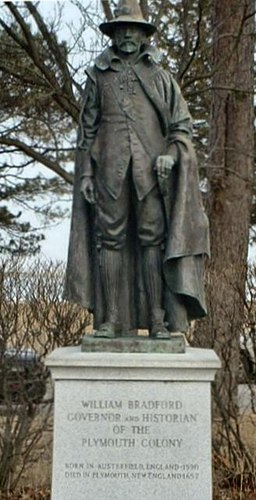Have you been following our Fun Facts Series? Over the weekend we shared some about the Mayflower and about the Pilgrims in general. Today I thought we would start to look at the Pilgrims individually a bit. I figured I would start with the one I am most interested in, William Bradford. I can trace my ancestry back to him, so I am always fascinated by his story.
- William Bradford was born on March 19, 1590 in Austerfield, Yorkshire, England. He was orphaned at a young age. His father died when he was one and he lived with his grandfather at age 4 when his mother remarried. At age 7 both his mother and grandfather passed away. He lived with his uncles, Robert and Thomas Bradford. They lived on a sheep farm.
- At age 12 he joined the neighboring town, Scrooby, Separatists. He probably learned to read at a school three miles away from his home. One of his favorite books was Foxe’s Book of Martyrs, which told about the brave people that were tortured or killed because of their religious beliefs differing from Queen Mary’s. In 1603 King James I became king and put out a law that Puritans could not meet by themselves.
- In the winter of 1607 he was thrown into jail with fellow Separatists when they boarded a ship for Holland. The ship’s captain had betrayed them. In August 1608 he finally joined the Separatists in Amsterdam, Holland. In Amsterdam William shared a house with the Brewsters and worked at a loom making silk.
- In 1613 he married Dorothy May. They have one son, John, together whom they leave in Leiden when they set sail on the Mayflower. Dorothy goes overboard and dies.
- William Bradford did much of the administrative planning for the Mayflower voyage.
- While exploring Cape Cod (while the Mayflower was in Provincetown), William Bradford got caught in deer trap set by Native Americans. It was made by strong ropes that wrapped around his ankles and held him in a tree upside down. He was one of the ten men who sailed in a small boat along the coast and found Plymouth. When they returned to the Mayflower he discovered his wife, Dorothy, had gone overboard in the shallow water and no one had been there to save her.
- The first winter the common house was used as a hospital. The common house was the first house built. William stayed in the common house due to his hip hurting so much he could not stand up. He was there when the thatched roof caught fire. There were barrels of gunpowder all around the common house. The Pilgrims were able to move the gunpowder and muskets out of danger and get all the sick people out without any deaths. Most of what William owned was lost in the fire.
- Squanto most likely lived in the same house as William Bradford when he moved into Plymouth. William Bradford wrote that Squanto was “a special instrument sent of God for their good.”
- In 1621 he becomes governor of the Plymouth Colony when Governor John Carver dies. He refused to be paid for the job. He was reelected thirty times.
- When the Fortune was first spotted in the sea, William gathered all the men and boys with their muskets in case it was not a friendly ship.
- In 1623 he marries Alice Carpenter Southworth arrived with her 2 sons and married William Bradford. She mothered his son left in Leiden (came to Plymouth) and they had 2 sons and a daughter. Alice moved into William’s sparse house with her sons and her sister’s family. His house had only one rug and two silver spoons. He taught all of his children to read and write.
- In 1648 William Bradford, Captain Miles Standish and three other men sold of a lot of land to pay off the loan they owed for the Mayflower and establishing Plymouth Colony.
- He was a very fair governor. He made sure the people voted for their leaders and that each man got an equal share of land. He made sure no one starved when food was sparse. He also made sure the church did not rule the people. If Strangers (the non-Separatists) wanted to join the church they were welcomed but it was not forced.
- He leaves public office in 1656 and dies several months later in 1657. He had shared the stories of Plymouth with his children and then wrote them down. He didn’t want people to forget how God had guided the little band of Pilgrims to the New World.
 |
| William Bradford's Birthplace: The Manor House Austerfield By Anne Hollingsworth Wharton [Public domain], via Wikimedia Commons |
 |
| Embarkation of the Pilgrims (pictured on the Speedwell) By Robert W. Weir (photograph courtesy Architect of the Capitol) (Architect of the Capitol) [Public domain], via Wikimedia Commons |
 |
| Statue of William Bradford near Plymouth Rock ToddC4176 at English Wikipedia [GFDL, CC-BY-SA-3.0 or Public domain], via Wikimedia Commons |
Sources:
- Herring, Marianne. William Bradford. Philadelphia. (2000) Chelsea House Publishers.
- Honiss Kelso, Dorothy. Beyond the Pilgrim Story: William Bradford. http://www.pilgrimhallmuseum.org/william_bradford.htm
- Philbrick, Nathaniel. The Mayflower and the Pilgrims’ New World. G.P. Putnam’s Sons. 2008. New York.


No comments:
Post a Comment
I love to hear your comments and ideas. Thank you for reading and contributing!